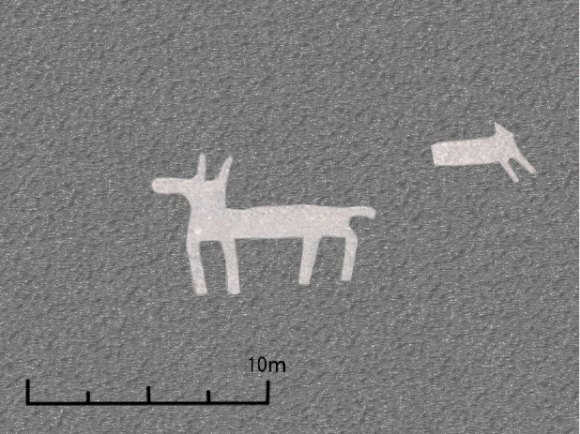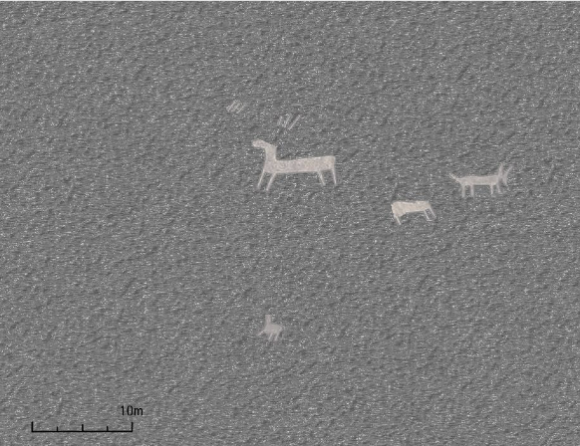
A team of researchers from Yamagata University in Japan announced this week that they have identified 24 new geoglyphs in Nazca, Peru, site of the UNESCO World Heritage Nazca lines.
The newly found geoglyphs are smaller than their famous peers, but estimated to be several centuries older.
The more famous Nazca geoglyphs are estimated to have been created between 400 and 650 AD with the largest spanning 270 meters (890 feet), while the newly discovered images date from 400-200 BC and range from just five to 20 meters (16-66 feet).
These smaller glyphs were carved into the side of hills so they could be clearly seen at the time of their creation.
Over time, natural and human erosion have degraded the lines of the artwork, making them difficult to spot, but the team used a 3-D scanner and photos to locate them. However, some are only partially visible and it’s difficult to tell what they are supposed to represent. Others are clearly llamas, an animal almost synonymous with the Andes.
The university has been studying the Nazca lines since 2004, setting up a full research center in Peru in 2012. Including 17 new geoglyphs found last year, the Japanese team has discovered 41 previously unknown glyphs in the area.
With the site just 1.5 kilometers (0.9 miles) from the expanding city of Nazca and in an area where mining takes place, the research team is now calling for conservation measures to preserve these new discoveries and protect the area for further research.
Source: Yamagata University via Mainichi Shimbun
Images: Yamagata University



 Class up your backyard with your very own Nazca hummingbird that smells so good!
Class up your backyard with your very own Nazca hummingbird that smells so good! Hot spring in Gunma Prefecture found to reduce COVID-19 infectivity by over 90 percent
Hot spring in Gunma Prefecture found to reduce COVID-19 infectivity by over 90 percent Cruising around Gunkanjima, Japan’s otherworldly “Battleship Island”【Photos】
Cruising around Gunkanjima, Japan’s otherworldly “Battleship Island”【Photos】 North Japan prefecture creates guide to help new foreign workers understand local language quirks
North Japan prefecture creates guide to help new foreign workers understand local language quirks Practical Zelda Tears of the Kingdom merch is here to be Hyrule-helpful in your daily life【Pics】
Practical Zelda Tears of the Kingdom merch is here to be Hyrule-helpful in your daily life【Pics】 Dark and edgy Jujustu Kaisen teams up with bright and cheery Sanrio for new merch line【Pics】
Dark and edgy Jujustu Kaisen teams up with bright and cheery Sanrio for new merch line【Pics】 Japanese samurai randoseru backpack lets you carry the bushido spirit with you wherever you go
Japanese samurai randoseru backpack lets you carry the bushido spirit with you wherever you go Does Starbucks Japan’s new holiday Frappuccino really taste like a cup of fallen snow?
Does Starbucks Japan’s new holiday Frappuccino really taste like a cup of fallen snow? Japanese Prime Minister once criticized deploying military to fight Godzilla
Japanese Prime Minister once criticized deploying military to fight Godzilla New heater-less pet kotatsu is a safe way to keep your furry friends warm this winter
New heater-less pet kotatsu is a safe way to keep your furry friends warm this winter New Akita Inu and Hachiko marshmallows are the best and squishiest souvenirs from Japan
New Akita Inu and Hachiko marshmallows are the best and squishiest souvenirs from Japan Discovered: An even better way to open Japanese convenience store rice balls【Video】
Discovered: An even better way to open Japanese convenience store rice balls【Video】 Sip with Snorlax – Clever drinkware design creates Pokémon in your glass with every pour【Pics】
Sip with Snorlax – Clever drinkware design creates Pokémon in your glass with every pour【Pics】 What’s the most popular way to prepare Japan’s beloved breakfast dish, Tamago Kake Gohan?
What’s the most popular way to prepare Japan’s beloved breakfast dish, Tamago Kake Gohan? Ten common characteristics of Japanese graphic design
Ten common characteristics of Japanese graphic design Nintendo’s controller capsule toys are so cool, even the machine you buy them from is awesome【Pics】
Nintendo’s controller capsule toys are so cool, even the machine you buy them from is awesome【Pics】 American gun owner opens our eyes to a different way of life in Tokyo
American gun owner opens our eyes to a different way of life in Tokyo Japanese communities giving their skylines a spring clean and saying goodbye to power lines
Japanese communities giving their skylines a spring clean and saying goodbye to power lines Burger King Japan creates Kyoto Whopper, its most Japanese burger ever, with Kyoto rice merchant
Burger King Japan creates Kyoto Whopper, its most Japanese burger ever, with Kyoto rice merchant Starbucks Japan unveils new Holiday goods for 2024
Starbucks Japan unveils new Holiday goods for 2024 Totoro stamp collection lets you add adorable Ghibli touches to cards and letters【Photos】
Totoro stamp collection lets you add adorable Ghibli touches to cards and letters【Photos】 Overwhelmed by modern social media? Japanese company is bringing back pagers with an emoji-twist
Overwhelmed by modern social media? Japanese company is bringing back pagers with an emoji-twist Studio Ghibli releases new insect whistle necklace from Nausicaä of the Valley of the Wind
Studio Ghibli releases new insect whistle necklace from Nausicaä of the Valley of the Wind Totoro sequel anime Mei and the Baby Catbus will screen at Ghibli Park this winter
Totoro sequel anime Mei and the Baby Catbus will screen at Ghibli Park this winter Tokyo Disneyland loses top-attendance crown for Japanese theme parks for second year in a row
Tokyo Disneyland loses top-attendance crown for Japanese theme parks for second year in a row Starbucks Japan unveils Halloween Frappuccino for 2024, and it’s like drinking a magic spell
Starbucks Japan unveils Halloween Frappuccino for 2024, and it’s like drinking a magic spell Evangelion creator Hideaki Anno returning to anime with new project for 50-year-old franchise
Evangelion creator Hideaki Anno returning to anime with new project for 50-year-old franchise Studio Ghibli releases new Howl’s Moving Castle goods that capture the magic from the anime movie
Studio Ghibli releases new Howl’s Moving Castle goods that capture the magic from the anime movie Adult Jam Bread causes a stir at store in Tokyo
Adult Jam Bread causes a stir at store in Tokyo What’s the deal with akebi, the perfectly purple, alien-like fruit that’s in season now in Japan?
What’s the deal with akebi, the perfectly purple, alien-like fruit that’s in season now in Japan? Kyoto becomes City of Yokai, with Night Parade of One Hundred Demons festival this autumn
Kyoto becomes City of Yokai, with Night Parade of One Hundred Demons festival this autumn McDonald’s new Happy Meals offer up cute and practical Sanrio lifestyle goods
McDonald’s new Happy Meals offer up cute and practical Sanrio lifestyle goods Foreign tourists on Shinkansen bullet train break suitcase etiquette, angering local passengers
Foreign tourists on Shinkansen bullet train break suitcase etiquette, angering local passengers [Deleted] Article written for April Fool’s Day 2018
[Deleted] Article written for April Fool’s Day 2018 Japanese government to make first change to romanization spelling rules since the 1950s
Japanese government to make first change to romanization spelling rules since the 1950s Foreigner’s request for help in Tokyo makes us sad for the state of society
Foreigner’s request for help in Tokyo makes us sad for the state of society Ghibli founders Toshio Suzuki and Hayao Miyazaki contribute to Japanese whisky Totoro label design
Ghibli founders Toshio Suzuki and Hayao Miyazaki contribute to Japanese whisky Totoro label design Japanese convenience store Family Mart announces abolishment of eat-in spaces
Japanese convenience store Family Mart announces abolishment of eat-in spaces Princesses, fruits, and blacksmiths: Study reveals the 30 most unusual family names in Japan
Princesses, fruits, and blacksmiths: Study reveals the 30 most unusual family names in Japan Doraemon found buried at sea as scene from 1993 anime becomes real life【Photos】
Doraemon found buried at sea as scene from 1993 anime becomes real life【Photos】 Life-size vibrating Legend of Zelda Master Sword for sale from Nintendo【Photos】
Life-size vibrating Legend of Zelda Master Sword for sale from Nintendo【Photos】 Japan seems just a little more terrifying with discovery of local leech’s superpower
Japan seems just a little more terrifying with discovery of local leech’s superpower Godzilla is finally discovered in the ocean’s depths!
Godzilla is finally discovered in the ocean’s depths! Japan petitions to add 40 traditional folk dances to UNESCO’s Intangible Cultural Heritage list
Japan petitions to add 40 traditional folk dances to UNESCO’s Intangible Cultural Heritage list First new Japanese cockroach species in 35 years discovered by scientists【Photos】
First new Japanese cockroach species in 35 years discovered by scientists【Photos】 Kicking for maximum swimming speed? You might be doing it wrong, Japanese researchers say
Kicking for maximum swimming speed? You might be doing it wrong, Japanese researchers say Try not to chuckle about this important Japanese discovery regarding great tits (the birds)
Try not to chuckle about this important Japanese discovery regarding great tits (the birds) Bones of over 1,500 people found at Osaka Station area construction site
Bones of over 1,500 people found at Osaka Station area construction site Real Fullmetal Alchemists: Kyoto University team fuses all 8 precious metals into single alloy
Real Fullmetal Alchemists: Kyoto University team fuses all 8 precious metals into single alloy “Hey, Japanese taxi driver, take us to the best Okinawan restaurant in Naha!”
“Hey, Japanese taxi driver, take us to the best Okinawan restaurant in Naha!” Nintendo buys five-billion yen plot of land, will build new development headquarters in Kyoto
Nintendo buys five-billion yen plot of land, will build new development headquarters in Kyoto Kyoto University finds alpacas may hold the key to preventing all COVID-19 variants
Kyoto University finds alpacas may hold the key to preventing all COVID-19 variants Miss Universe contestants promote inner beauty with no-make-up selfies
Miss Universe contestants promote inner beauty with no-make-up selfies Tokyo University research team develops world’s first hybrid robot with real working muscles
Tokyo University research team develops world’s first hybrid robot with real working muscles Buying a house in Tokyo? This town is giving away brand new homes to applicants in Japan
Buying a house in Tokyo? This town is giving away brand new homes to applicants in Japan University of Tokyo students can show off school pride with new jacket boasting ID display pocket
University of Tokyo students can show off school pride with new jacket boasting ID display pocket
Leave a Reply